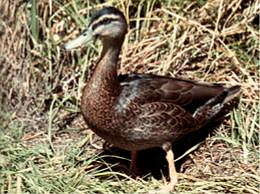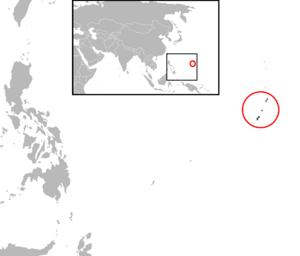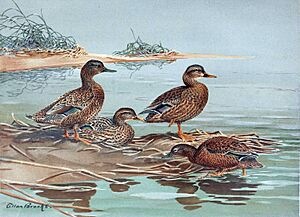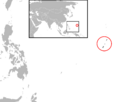Mariana mallard facts for kids
Quick facts for kids Mariana mallard |
|
|---|---|
 |
|
| The last Mariana mallard drake, a bird of the "superciliosa" morph. | |
| Conservation status | |
| Scientific classification | |
| Genus: |
Anas
|
| Species: |
oustaleti
|
 |
|
| Former distribution of the Mariana mallard | |
| Synonyms | |
|
|
The Mariana mallard or Oustalet's duck (Anas oustaleti) was a type of duck that is now extinct. This means it no longer exists anywhere in the world. It lived only on the Mariana Islands, which are a group of islands in the Pacific Ocean. Scientists have debated whether it was a full species of its own, or a subspecies (a special type) of the mallard or the Pacific black duck.
Contents
About the Mariana Mallard
The Mariana mallard looked like a mix between the mallard and the Pacific black duck. These two duck species are closely related and often create hybrid offspring. Male Mariana mallards had two main looks, called "morphs." These were named "platyrhynchos" and "superciliosa" because they looked more like one of the parent species.
A scientist named Tommaso Salvadori first described this duck in 1894. He named it after Emile Oustalet, a French zoologist who collected it. The local people also had names for it. The Chamorro people called it ngånga' (palao), and the Carolinian people called it ghereel'bwel.
Scientists have long discussed how to classify the Mariana mallard. Some thought it was a subspecies of the mallard. Others believed it might have been a new species that formed from the mallard and Pacific black duck mixing over time. However, there is no DNA evidence to fully prove this idea.
What Did They Look Like?
Mariana mallards were about 51 to 56 centimeters (20 to 22 inches) long. They weighed around 1 kilogram (2.2 pounds). This made them a little smaller than regular mallards.
Male ducks of the "platyrhynchos" type had special breeding feathers. Their heads were green, like a male mallard, but less shiny. They had a dark brown stripe near their eyes. Their chest was a reddish-brown with dark spots. Their wings had a special patch of feathers, called a speculum, similar to a mallard.
Males of the "superciliosa" type looked more like a Pacific black duck. Their heads were not as clearly marked. Their chests and sides had broader buff edges. Their wings usually had the mallard-like speculum.
Female Mariana mallards looked mostly like dark female mallards. Their feet and the tip of their bill were a purer orange color.
Where Did They Live?
In recent times, the Mariana mallard lived on the islands of Guam, Saipan, and Tinian. These islands are part of the Mariana Islands. There were also reports of two unidentified ducks on Rota in 1945. However, it's unlikely the ducks traveled between Guam and Rota because the distance is nearly 80 kilometers (50 miles).
Life and Habits
The Mariana mallard lived in wetlands, which are areas with lots of water, like swamps and marshes. They preferred places inland, but sometimes lived near the coast. On Guam, they were often found in the Talofofo River valley. On Tinian, they lived around Lake Hagoi and Lake Makpo. On Saipan, they were seen in the Garpan Lagoon and near Lake Susupe.
These ducks were quite shy. They liked sheltered areas with many water plants, such as ferns and reeds. They also built their nests in these thick plants. Usually, they were seen in pairs or small groups. But in their favorite spots, larger groups of dozens of birds could be found. Sometimes, up to 50 or 60 individuals were seen together. These ducks did not migrate, meaning they stayed in the same area year-round.
Reproduction and Diet
Mariana mallards ate aquatic invertebrates (like insects), small vertebrates, and plants. They likely fed by tipping their bodies upside down in the water, just like mallards do.
They were recorded breeding from at least January to July. The most active breeding time was in June and July, at the end of the dry season. Sometimes, they might have bred almost all year.
Female ducks laid clutches of 7 to 12 pale grey-green eggs. Each egg was about 6.16 x 3.89 centimeters (2.4 x 1.5 inches). The eggs hatched after about 28 days. Male ducks did not help with incubating the eggs or raising the ducklings. The young ducklings could move around soon after hatching. They learned to fly when they were about eight weeks old. They became old enough to have their own ducklings the following year.
Why Did They Disappear?
The Mariana mallard population decreased because their wetland homes were drained. This happened to make space for farming and building. Hunting also put a lot of pressure on the ducks. Even though there was a ban on guns when Japan controlled the islands (1914–1945), the ducks were easy to catch in traps. The gun ban was lifted after World War II. By the 1940s, it was rare to see more than a dozen birds together.
On Guam, the last Mariana mallard was seen in 1967. On Tinian, the last sighting was in 1974. Lake Susupe on Saipan had the most habitat for them. So, the Saipan population lasted a few more years.
The Mariana mallard was listed as an endangered species in 1977. In 1979, two males and one female were found on Saipan and captured. One male was later released, which was the last wild Mariana mallard ever seen. The remaining pair was taken to Hawaii and then to SeaWorld San Diego. Scientists tried to get them to reproduce in captivity, but they were not successful. The species became extinct when the very last individual died in 1981.
Surveys were done in the years after, but no more Mariana mallards were found. The species was officially removed from the endangered species list in 2004 because it was extinct.
Images for kids










